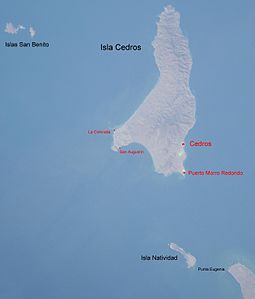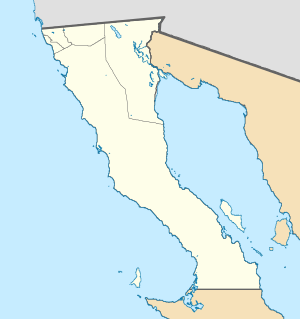Islas San Benito
| Islas San Benito | ||
|---|---|---|
| Image from the space shuttle ; entire archipelago top left | ||
| Waters | Pacific Ocean | |
| Geographical location | 28 ° 18 ′ N , 115 ° 35 ′ W | |
|
|
||
| Number of islands | 3 | |
| Main island | San Benito del Oeste | |
| Total land area | 3.899 km² | |
| Residents | uninhabited | |
The Islas San Benito are a Mexican archipelago made up of three small islands that are uninhabited except for two lighthouse keepers, 25 km west of Isla de Cedros in the Pacific . They belong to the Delegación Isla de Cedros , part of the Ensenada municipality in the state of Baja California .
They are barren islands with a total area of 3.899 km², surrounded by rocks and fields of seaweed. A census from 2005 showed two residents on Benito del Oeste (West Benito), at the 2010 census, the island, like the other two islands, was uninhabited.
Geography and ecology
Benito del Oeste (West Benito, 2.6 km²) is the westernmost and largest island in the group. It rises as a plateau up to 203 m high from the sea near the center. A 4 m high lighthouse is in the south. The more important beacon, a 17 m high tower with residential buildings, is located in the extreme northwest. The Rocas Pinaculo , two rocky cliffs, are 1.6 km to the west.
Benito del Centro (Central Benito, 0.4 km²) and Benito del Este (East Benito, 0.9 km²), the other two islands, are not far east of Benito del Oeste and are separated from it by the Canal de Peck , a deep 65 m wide canal. Benito del Este has four to 140 m high, clearly demarcated hills. Benito del Centro is flat with a highest elevation of 25 m near its east end.
The vegetation consists mainly of low shrubs and herbs as well as some large cacti ( Cylindropuntia prolifera , Cylindropuntia ramosissima ). There are few animals and no mammals on land. Birds are not particularly numerous due to the barreness of the islands, but the Aleutian aalk is plentiful during the breeding season .
Individual evidence
- ^ Catálogo de Localidades
- ↑ Archive link ( Memento of the original dated December 8, 2007 in the Internet Archive ) Info: The archive link was inserted automatically and has not yet been checked. Please check the original and archive link according to the instructions and then remove this notice.
- ↑ http://permanent.access.gpo.gov/websites/pollux/pollux.nss.nima.mil/NAV_PUBS/SD/pub153/153sec02.pdf

